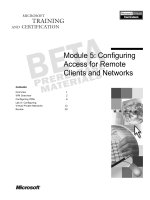Tài liệu UNIT 5. ONLINE FACILITATION LESSON 2. FACE-TO-FACE AND ONLINE FACILITATIONNOTE docx
Bạn đang xem bản rút gọn của tài liệu. Xem và tải ngay bản đầy đủ của tài liệu tại đây (1020.84 KB, 11 trang )
5. Online Facilitation - 2. Face-to-face and Online Facilitation - page 1
Information Management Resource Kit
Module on Building Electronic
Communities and Networks
UNIT 5. ONLINE FACILITATION
LESSON 2. FACE-TO-FACE AND
ONLINE FACILITATION
© FAO, 2006
NOTE
Please note that this PDF version does not have the interactive features
offered through the IMARK courseware such as exercises with feedback,
pop-ups, animations etc.
We recommend that you take the lesson using the interactive courseware
environment, and use the PDF version for printing the lesson and to use as a
reference after you have completed the course.
5. Online Facilitation - 2. Face-to-face and Online Facilitation - page 2
At the end of this lesson, you will be
able to:
• identify similarities and differences
between face-to-face and online
facilitation.
Objectives
The role of the facilitator, both online and
offline, is to make it easier for groups to
work together and achieve their goals.
While there are many similarities between
face-to-face and online groups, and the
core facilitation tasks are the same, there
are also important differences.
As a consequence, an online facilitator
needs to handle certain tasks and
challenges in a different and new way, or
deal with completely new problems.
This lesson will focus on these differences.
Introduction
5. Online Facilitation - 2. Face-to-face and Online Facilitation - page 3
The two most important differences between face-to-face and online groups
relate to space and time:
An online meeting, workshop or
discussion takes place with participants
in different places, and (usually)
asynchronously – with participants
separated in time as well as place.
Online and offline groups
A face-to-face meeting, workshop
or discussion takes place with all
participants in the same place at
the same time.
FACE-TO-FACE
ONLINE
Time and place influence many aspects of the group:
Online and offline groups
The facilitator has no control over physical
factors such as how and when group members
access the Internet.
The facilitator has (at least some)
control over physical factors such as
seating arrangements, timing of
breaks and so on – and can use
these as a facilitation tool.
With asynchronous groups communication is
not immediate.
Communication is immediate.
There may be a feeling of anonymity among
participants, who feel they do not know (and
are not known by) others in the group.
Participants can generally see, hear
(even touch!) other participants,
which breaks down anonymity.
Text is the main mode of communication.
Non-verbal communication is very limited, and
there are no “physical cues” such as tone of
voice or gestures to communicate meaning.
Verbal communication is the main
mode of communication, supported
by non-verbal communication such as
body-language, behaviour, and visible
appearances that may provide
information about the participant’s
gender, age, race, mood, and status.
In an online group…In a face-to-face group
5. Online Facilitation - 2. Face-to-face and Online Facilitation - page 4
In your opinion, how do the following aspects relate to face-to-face and online groups?
Online and offline groups
In an online group…In a face-to-face group
The individual participant decides
time and location to attend the
discussion.
No technological skills are required
in order to access the group.
Group meets for fixed period of
time. Possibilities for extending this
time are usually very limited.
Group members may face other
demands on their time and
attention.
Click on each option and drag it to the corresponding box.
When you have finished, click on the Confirm button.
a
b
1
2
3
4
Differences between face-to-face and online groups impact tasks of offline and online
facilitators.
For example, in designing group activities
Online and offline facilitation tasks
In housekeeping
ONLINEFACE-TO-FACE
ONLINEFACE-TO-FACE
The facilitator
announces
logistics-type
information:
facilities, special
requests etc.
Many activities may run
parallel. The facilitator has
to set up different “threads”
for parallel discussion of
various topics.
Activities are in large
measure sequential:
topics are discussed
one-by-one, with
occasional use of
parallel sessions.
The facilitator circulates
“house rules” and
netiquette (“network
etiquette”) guidelines for
acceptable behaviour in
online communities.
5. Online Facilitation - 2. Face-to-face and Online Facilitation - page 5
Some aspects of the discussions are different. For example:
ONLINEFACE-TO-FACE
Discussion
is oral and
immediate.
To take decisions and agree on action,
the facilitator asks participants to
indicate agreement orally or by a
show of hands. Decisions are finalized
in “real time”.
The facilitator has to summarize the
discussions quickly with little time for
reflection, and presents summaries
orally in real time.
Discussion is written,
and (except in
synchronous online
spaces) there is a time
lag of hours, days or
more between
comments.
The facilitator asks participants to indicate
agreement in writing, or by responding to
an online poll. Except in synchronous online
spaces, decisions can take days or more to
be finalized.
Except in synchronous online spaces, the
facilitator has time to process written
information about decisions.
Online and offline facilitation tasks
Throughout a meeting, online and offline facilitators have the same tasks, such as
ensuring listening and understanding and managing conflict. However
“Listening” means
interpreting
written messages.
Communication is
documented, and
there is time to
reflect on
interpretation.
Conflict needs to be
resolved in a short
period of time. Not
always possible to deal
with conflict away from
main group.
Conflict can be resolved
over a period of days or
weeks. Easy and sometimes
more appropriate to
communicate privately with
individuals to help resolve
conflicts.
ONLINEFACE-TO-FACE
“Listening” is aural.
Even if communication is
documented (through written
notes or through audio or video
recordings), facilitator and
participants are responding to
what they have just heard.
Facilitator needs to focus on
the moment.
ONLINEFACE-TO-FACE
Online and offline facilitation tasks
5. Online Facilitation - 2. Face-to-face and Online Facilitation - page 6
Same problems, new solutions
Imagine you see participants to a face-to-face
meeting slumping in their seats and yawning.
A diagnosis of low energy levels is obvious!
As facilitator, you can address this by calling a
five-minute break and getting participants to
stretch and walk around the room.
In an online discussion, you may notice that there are
very few postings or responses to questions.
Unlike the yawning face-to-face group, the diagnosis
is not clear.
You may have to look at other possibilities (e.g.
confusion, community members being on holiday,
etc.) before concluding that the problem is low energy
levels, and addressing this through a new activity or a
change of pace.
Same problems, new solutions
As opposed to face-to-face meetings, in
online meetings there are no visual
cues to help you understand silence or
recognize a low energy level. Moreover,
how the facilitator identifies and
addresses these problems is different.
In these situations, the online facilitator
may have to rely on different
techniques to achieve the same
goals as the face-to-face facilitator.
5. Online Facilitation - 2. Face-to-face and Online Facilitation - page 7
Issues requiring more effort
Facilitators need to sustain motivation of the group’s participants, for example during a
meeting.
In your opinion, is this task more challenging for an online or a face-to face facilitator?
online facilitator
face-to-face facilitator
Please click on the answer of your choice
Participants in an online community have
many other immediate demands and
distractions on their time.
Sustaining motivation and active participation
on an ongoing basis is a particular challenge
for the online facilitator.
Participant motivation is a big issue for the online facilitator, while it may be less time
consuming in face-to-face facilitation.
In a face-to-face group participants are not
always highly motivated to take an active part in
discussions.
However, they are to some extent a “captive
audience”. Once they are physically present
in the room, people often (though not always)
think they “might as well participate”.
Issues requiring more effort
5. Online Facilitation - 2. Face-to-face and Online Facilitation - page 8
In your opinion, what strategy works best to encourage participant
motivation in an online space?
Explain how easy it is to write a message to the group.
Make sure that all participants are introduced to each
other and understand and support the common purpose
of the group.
Make it easier to contribute by providing the participants
with a ready-made plan of action.
Please click on the answer of your choice
Issues requiring more effort
Overcoming anonymity and building trust
and relationships can be a particular
challenge for the online facilitator.
If participants have never met, particularly if
they come from different language groups,
cultures, regions, or if there are any other
significant differences between them,
community building will require a high level
of ongoing effort from the facilitator.
The facilitator will also have to pay close
attention to ensuring understanding across
the different groups.
Issues requiring more effort
5. Online Facilitation - 2. Face-to-face and Online Facilitation - page 9
While some groups come together online
in order to achieve specific outcomes (e.g.
collaborative projects), many online
groups are ongoing and have broader
aims, such as general networking and
sharing of information.
Facilitators need to sustain participation in
the long term, without a formal agenda to
structure community interaction.
The membership of such groups is also
likely to change over time, and the
facilitator needs to be aware of the
changes in group dynamics this may bring.
Issues requiring more effort
Facilitating ongoing interaction is another challenging task for an online facilitator.
UNEQUAL ACCESS
Unequal access to the online space because of limitations in Internet access or computer
skills can create frustration, irritation, and uneven participation in the discussion and
information exchange.
The facilitator needs to
• find the group’s common denominator for access: What is the baseline access? Does
everyone have e-mail access? Web access? Do they have access daily, weekly or
monthly?
• explain to the group the different ways in which participants access the online space;
and
• give individual support to participants who need it.
Online facilitation challenges
Finally, the facilitator of an online space is likely to experience challenges that are
unique to the online environment:
VARYING GROUP
Participants may come and go (especially if they can subscribe and unsubscribe without
help from the facilitator) and most participants go through stages of intense participation
and periods of relative inaction.
The facilitator should be actively involved in building an inclusive and enthusiastic
online community: ask newcomers to introduce themselves, make new participants feel
comfortable about joining already established discussions, create summaries of past
discussions so newcomers can catch up quickly, be enthusiastic and motivate
participants.
5. Online Facilitation - 2. Face-to-face and Online Facilitation - page 10
Online facilitation challenges
ONLINE TECHNOLOGY
The facilitator's task is to liaise with the people responsible for the technology
to ensure that everything functions as it should.
The facilitator also needs to ensure that community members are
comfortable with the technologies that support the group. It is important
for the facilitator to be able to use and teach others to use the tools, at least
at a basic level, and he/she may need to provide individual support to
community members who are struggling with technical problems.
From here you can download and print documents that can be used to make a more detailed
comparison between online and offline facilitation.
Face-to-face and online facilitation: an example
Now that you have learned about the differences
between offline and online facilitation of a meeting, let’s
look at an example.
Face-to-face and online facilitation tasks
This document compares face-to-face and online
facilitation tasks in different phases of a group process.
Job aids
5. Online Facilitation - 2. Face-to-face and Online Facilitation - page 11
Summary
There are many similarities between face-to-face and online group facilitation.
Important differences between face-to-face and online facilitation are the result of the
influence of time and space on the communication process:
• some facilitation tasks are the same for both offline and online facilitators, even if
they need to be performed using different techniques;
• other tasks, such as sustaining participant motivation, are particularly challenging for
online facilitators;
• finally, online facilitators may face some completely new challenges related to the
specific nature of an online community.
Technology can become an obstacle in the facilitation process if it doesn’t work
smoothly in the background.
If you want to know more…
Online Resources
James, M.; Rykert, L. 1998. From Workplace to Workspace: Using E-mail Lists to Work Together.
Ottawa, IDRC.
/>Bellanet. Mailing List Facilitation
/>Full Circle Associates. Online and Offline Facilitation: Different Yet Alike?
/>Full Circle Associates. Facilitating and Hosting a Virtual Community.
/>









